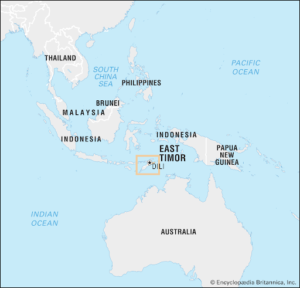In news– The second and final round of its presidential election was held in East Timor recently.
East Timor: Country profile-
- East Timor, also known as Timor Leste comprises the eastern half of Timor island, the western half of which is part of Indonesia.
- Australia is the country’s southern neighbour, separated by the Timor Sea and Dili is its capital.
- It spans a 15,000 square km (5,792 square mile) land area – slightly smaller than Israel.

- It is one of only two predominantly Catholic nations in Southeast Asia, the other being the Philippines, as well as the only country in Asia to be located completely in the Southern Hemisphere.
- Most of the people are of Papuan, Malayan, and Polynesian origin and are predominantly Christian.
- About 40 different Papuan and Malayan languages or dialects are spoken, dominated by Tetum.
- Portuguese is spoken by a small fraction of the population, but it is one of the country’s two official languages, the other being Tetum; Indonesian and English are considered to be “working” languages.
- It was colonised by Portugal in the 18th century and remained under its control until 1975.
- When the Portuguese withdrew, troops from Indonesia invaded and annexed East Timor as its 27th province.
- The East Timorese voted for independence in a 1999 UN-supervised referendum, but that unleashed even more violence until peace-keeping forces were allowed to enter.
- The country was officially recognised by the United Nations in 2002.
- It has also applied to be a member of the Association of Southeast Asian Nations (ASEAN) and currently holds observer status.
- In East Timor’s political system, the president also shares some executive powers and appoints a government and has the power to veto ministers or dissolve parliament.
- The country depends on revenues from its offshore oil and gas reserves which account for 90% of its gross domestic product.
- Its main revenue stream, the Bayu Undan gas field, is set to dry up by 2023 and the country is now planning to collaborate with companies like Australia’s Santos to turn it into carbon capture facilities.
Source: The Indian Express
















